Motherwell, Strathclyde, Scotland, UK – Sunday, June 20th, 2010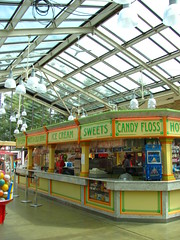
After falling in love with the Scottish soil over four days in Edinburgh, M&Ds Scotland’s Theme Park (just outside of Glasgow) would have tough work ahead of it to reverse that opinion of a nation in only a single day, but it seemed up to the challenge. Home to no less than four Pinfari death traps… excuse me, roller coasters, one of which is a routine contender for the worst steel roller coaster in the world in internet polls, in an amusement center that better resembles a cheap carnival than any actual thematically integrated park as the name would have you believe. From poor planning I failed to take note that nearby Loudoun Castle was home to a Schwarzkopf Silverarrow (sadly closed at the end of the 2010 season), which suffices to say would have been a much better attraction than any found inside the gates of M&D’s, but I doubt I would have had the stamina to fit two parks into a single day whilst relying on public transport schedules anyway… plus there was something exciting and adventurous about going to a park that promised to be awful on so many levels that anything better would have been a worse use of time (plus I would have gotten fewer new credits at Loudon, not that I care to count…) I needed to visit only one park in Glasgow to add a new nation to my list of parks visited in, although I was never sure (maybe someone can answer me this?) if I could claim 415 roller coasters between eleven countries including England, Scotland and Wales, or only in nine countries including the United Kingdom? Yes, I realize this question almost certainly relegates me to the lowly status of yet another dumb, loud American tourist.
exciting and adventurous about going to a park that promised to be awful on so many levels that anything better would have been a worse use of time (plus I would have gotten fewer new credits at Loudon, not that I care to count…) I needed to visit only one park in Glasgow to add a new nation to my list of parks visited in, although I was never sure (maybe someone can answer me this?) if I could claim 415 roller coasters between eleven countries including England, Scotland and Wales, or only in nine countries including the United Kingdom? Yes, I realize this question almost certainly relegates me to the lowly status of yet another dumb, loud American tourist.
The first attraction on my agenda was the Runaway Mine Train, a moderate-sized children’s roller coaster that I at first thought was from L&T Systems due to the similarity to a ride I had been on in Ocean City, New Jersey but later researched to be made by a company called Barbisan. Nevertheless, despite who built it or its relatively slow speeds, it proved to be one of the more intense children’s coasters I’ve come across, with punishingly hard laterals around the helices and curved drops. I suspect that for many, this might be as good as M&Ds gets (perhaps due to the absence of any overhead restraining device), though I still held out optimism for the larger rides further down the midway.
Express is a ride in the traditional mold of Pinfari’s popular Galaxi coasters, although the layout configuration is streamlined and modernized (in other words, shorter and more boring with the absence of the sharp drops and long downhill helices). Its vehicles also feature over the shoulder harnesses,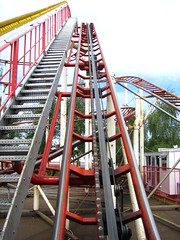 a highly questionable augmentation given there are no forces that would require that degree of upper body restraint save for the bashing around corners in which the hard padding is there to protect our ears and collarbones from what otherwise would have been thin air. Mercifully this was not a significant problem as the Italian designers smoothed out their layout in a style reminiscent of a miniature Super 8er Bahn, all it in fact did was make a mediocre layout seem even more safe and banal. Just when it seems like it should be working up the speed to do something interesting, the brakes come on and your left on the unload platform wondering if the absence of any queue still warrants a re-ride or if there are any better future possibilities to do with your life in the immediate moments that follow despite being stranded at M&Ds for the day. I chose the latter (but was back later).
a highly questionable augmentation given there are no forces that would require that degree of upper body restraint save for the bashing around corners in which the hard padding is there to protect our ears and collarbones from what otherwise would have been thin air. Mercifully this was not a significant problem as the Italian designers smoothed out their layout in a style reminiscent of a miniature Super 8er Bahn, all it in fact did was make a mediocre layout seem even more safe and banal. Just when it seems like it should be working up the speed to do something interesting, the brakes come on and your left on the unload platform wondering if the absence of any queue still warrants a re-ride or if there are any better future possibilities to do with your life in the immediate moments that follow despite being stranded at M&Ds for the day. I chose the latter (but was back later).
Working my way up the roller coaster ranks (or down, depending on your perspective), I next elected to join the queue for Tsunami, another Pinfari portable coaster in a looping inverted configuration. That descriptor did not bode well for me as I climbed into the car for the first time wondering what exciting new forms of torture I would have to endure. The frail, two-tube track supported by PVC tubing with vehicles apparently manufactured by Mattel might be cute fun if this were a children’s coaster but all seems more than a little risky when suspended beneath the track and expected to generate enough speed and force to make it upside down a couple of times. Completely unnecessary three train operation (does this thing even have three block breaks on it?)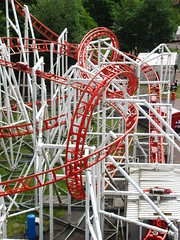 meant I was loaded and locked in before I could change my mind.
meant I was loaded and locked in before I could change my mind.
I returned to the station pleasantly surprised. That was due more to the low expectations set, like when you’re expecting to get punched in the jaw but instead are asked how your day is going. The seats were well padded and the track ran smoothly (enough), with a degree of competence in the design that meant no unnecessary jolts or rough patches due to a poor understanding of how forces relate to gravity or an unwillingness to bend steel into more complicated shapes than circles and straight. Plus, honestly, the first double rollover maneuver is quite fun because it’s such a smaller scale than any other looping invert I’ve been on. It’s sort of like the SLC’s but the second inversion is more of a corkscrew due to space constrictions. The rest of the layout is a collection of random banked turns (some fast, some not) to fill a lot, concluding with an odd brake run banked downhill. I actually went around and did it twice more immediately after my first ride, and a total of seven or eight rides throughout the afternoon.
Now I’m jazzed up with a good mojo working. The last three roller coasters ranged from inoffensively forgettable to momentarily enjoyable when they were all expected to be uniformly awful. Would my luck continue through to the last one, the biggest (and reputedly worst) on offering at M&Ds, the Tornado?
If there is one thing that Pinfari is adept at, it’s presentation. The Tornado stands ‘only’ 78 feet tall, yet standing there in person contemplating riding such a flimsily built attraction I might have been persuaded that it was nearer 178’. (It’s still officially Pinfari’s largest model attraction to date.) Chalk it up to the small gauge track of similar construct to Tsunami and Express, with its improbably slender lift hill rising directly away from me on the midway in a profile distantly similar to that of the approach to Millennium Force. Things get off to an okay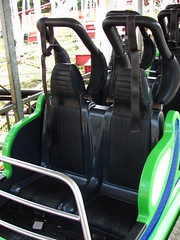 start with a long, curving drop to ground level that’s too shallow to be jarring yet still feels psychologically
start with a long, curving drop to ground level that’s too shallow to be jarring yet still feels psychologically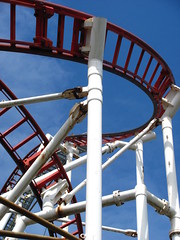 dangerous due to the speed of the petite vehicles we’re strapped into that seem to have us seated inches above the floor and with a harness that forces us to fold our arms over the top edge of the vehicle sides like we’re the Blues Brothers cruising the streets in our Cadillac. There’s a gentle rise followed by a second drop mirroring the first. This feeds directly into a pair of large, fast and forceful vertical loops. A good choice of inversion lineup as they require virtually no lateral or rotational movement, something that I expect should try to be avoided at all costs.
dangerous due to the speed of the petite vehicles we’re strapped into that seem to have us seated inches above the floor and with a harness that forces us to fold our arms over the top edge of the vehicle sides like we’re the Blues Brothers cruising the streets in our Cadillac. There’s a gentle rise followed by a second drop mirroring the first. This feeds directly into a pair of large, fast and forceful vertical loops. A good choice of inversion lineup as they require virtually no lateral or rotational movement, something that I expect should try to be avoided at all costs.
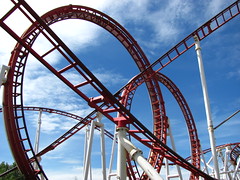 A hard jolt awaits us on the exit of the loops in the transition into the next turn,
A hard jolt awaits us on the exit of the loops in the transition into the next turn, 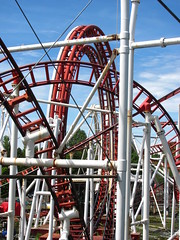 where things slow down for an elevated dip into a small camelback hill that tries its darndest to provide a bit of airtime for those on the extremes of the five-car train, followed by a descending helix that builds up speed as we return to ground level for the final leg of the course. We get a quick overbanked turn that seems to be vaguely trying to channel the Stengel dives on Maverick, which leads directly into a hopping s-curve over the final descending helix into the brakes.
where things slow down for an elevated dip into a small camelback hill that tries its darndest to provide a bit of airtime for those on the extremes of the five-car train, followed by a descending helix that builds up speed as we return to ground level for the final leg of the course. We get a quick overbanked turn that seems to be vaguely trying to channel the Stengel dives on Maverick, which leads directly into a hopping s-curve over the final descending helix into the brakes.
 Somewhere around here, I think by the wannabe Stengel dive, was formerly located a third corkscrew inversion that had since been removed in an effort to save lives. While at the park I scoured over the trackwork trying to figure out exactly where the replacement track bridged the gap left by this maneuver. Upon returning home I did some more research online and found my answer as to how the corkscrew fit into the layout: it didn’t. Stumbling across this video from 1999 by David J. Ellis, I literally laughed out loud the first time when it got to the corkscrew (1:25), where it less resembles roller coaster POV footage than it does a first person camcorder view of a political insurrection just as the military starts firing.
Somewhere around here, I think by the wannabe Stengel dive, was formerly located a third corkscrew inversion that had since been removed in an effort to save lives. While at the park I scoured over the trackwork trying to figure out exactly where the replacement track bridged the gap left by this maneuver. Upon returning home I did some more research online and found my answer as to how the corkscrew fit into the layout: it didn’t. Stumbling across this video from 1999 by David J. Ellis, I literally laughed out loud the first time when it got to the corkscrew (1:25), where it less resembles roller coaster POV footage than it does a first person camcorder view of a political insurrection just as the military starts firing.
I got off the Tornado not as shaken as that video camera, just sort of ambivalent, as if I had only ridden it in a dream. I wasn’t actively turned off by the whole experience, but I wasn’t sure if I should press my luck on a second ride, so I held off. I like to think I’m not as hyperbolic when it comes to rating rides as many others are; I’m unlikely to declare a ride a work of genius except for in very rare cases (including the last park I visited), yet I’m also unlikely to completely hate on a ride that many declare to be the worst they’ve ever been on. The playing field I think is more even than is often described to be, with most coasters sharing the same setbacks and achievements regardless of the size or shape they take.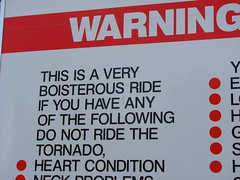
My second ride later in the afternoon meant that several weeks later after I was back home in Michigan, my mom asked me how I got a large bruise on my upper arm. I had to explain that I had gotten in on a roller coaster in Scotland after a particularly jarring transition after a loop when I had my arm tucked into the car instead of over the side. After that second ride I simply declared “nevermore,” and that was all that needed to be said about the Tornado. Worst steel roller coaster I’ve ever been on? Quite probably, but that’s not as special a designation as it might otherwise sound. If anything, the worst roller coaster is the most forgettable one, which is honestly the most damning criticism I’d have against Tornado before anything else. Though maybe that was due to amnesia.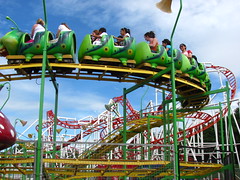
I made a quick credit grab of the Big Apple, the firth of forth, err, the fourth of four Pinfari coasters at M&Ds and also the first without over the should restraints. Although the park had several other non-coaster rides, most of the flats appeared to be pretty weak, generic carnival rides which I didn’t even bother riding despite having an unlimited wristband. (I believe M&Ds also operate carnivals in Scotland and their theme park is a permanent grounds for several of their traveling rides.) The only other two rides I took the time to sample were the Moby’s Revenge water slide (decent ride, not wet at all and would have been worth doing more if not for a low capacity) and the Big Wheel, primarily to snap a few pictures from the top of its 115 foot diameter.
 I’m a bit disappointed that M&Ds is the best park Scotland has. That’s not to rip on them too much as they offer a decent ride selection at a competitive price for the folk of Glasgow, but to the eyes of this foreign traveler it struck me that the Scottish landscape offers so much potential that it seems squandered on a funfair park laid over a flat piece of land. I could just imagine someplace in the styling of Lightwater Valley or Oakwood located on the shores of a loch with a large terrain wooden coaster wandering through the eaves of the forest up and down the side of a large bluff. That would be something I’d return to Scotland for in a heartbeat.
I’m a bit disappointed that M&Ds is the best park Scotland has. That’s not to rip on them too much as they offer a decent ride selection at a competitive price for the folk of Glasgow, but to the eyes of this foreign traveler it struck me that the Scottish landscape offers so much potential that it seems squandered on a funfair park laid over a flat piece of land. I could just imagine someplace in the styling of Lightwater Valley or Oakwood located on the shores of a loch with a large terrain wooden coaster wandering through the eaves of the forest up and down the side of a large bluff. That would be something I’d return to Scotland for in a heartbeat.
I still had a couple hours between leaving the park and my scheduled departing train for Blackpool so I elected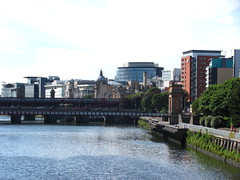 to do a bit more urban sightseeing and wander the streets of downtown Glasgow. Although technically the larger city, to me it seemed smaller than Edinburgh, perhaps due to fewer remaining historical structures for the tourists to look at. It was nevertheless a pleasant place to spend a few hours, stopping by one of the UK’s many free art museums, strolling along the banks of the River Clyde, and stopping to see a neat Scottish bagpipe and drum group on Buchanan Street. Eventually 5:30 rolled around and I boarded my train to Preston, where I was pleased to find that I had somehow been assigned a place in 1st class that included free wireless internet. I was now entering the final leg of my trip, and some of the biggest and best I’d experience in the European continent soon awaited me.
to do a bit more urban sightseeing and wander the streets of downtown Glasgow. Although technically the larger city, to me it seemed smaller than Edinburgh, perhaps due to fewer remaining historical structures for the tourists to look at. It was nevertheless a pleasant place to spend a few hours, stopping by one of the UK’s many free art museums, strolling along the banks of the River Clyde, and stopping to see a neat Scottish bagpipe and drum group on Buchanan Street. Eventually 5:30 rolled around and I boarded my train to Preston, where I was pleased to find that I had somehow been assigned a place in 1st class that included free wireless internet. I was now entering the final leg of my trip, and some of the biggest and best I’d experience in the European continent soon awaited me.
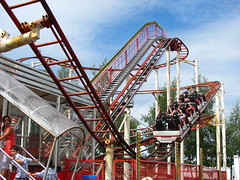
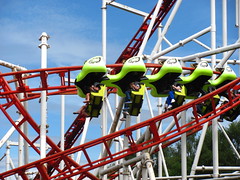








Comments